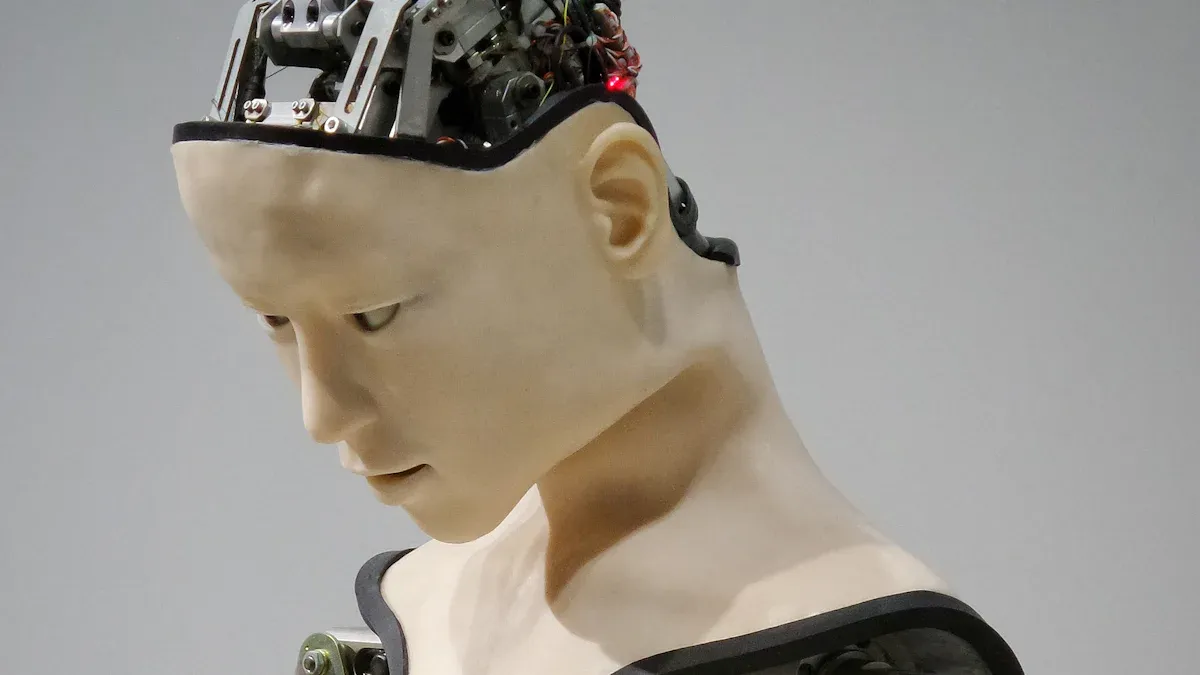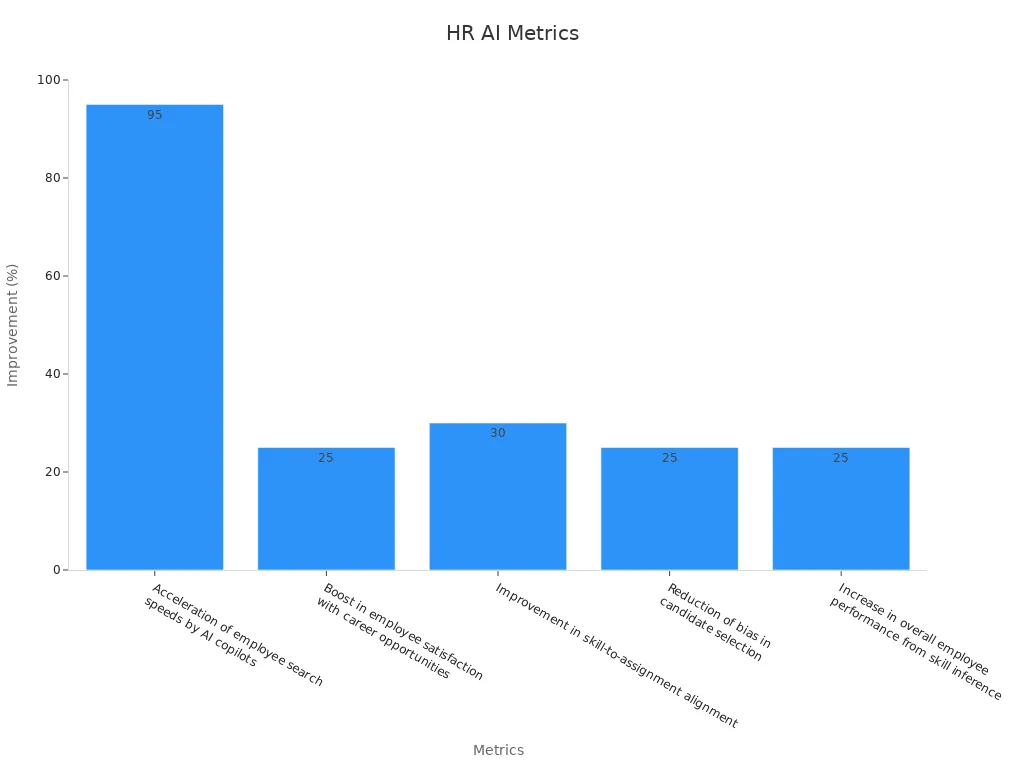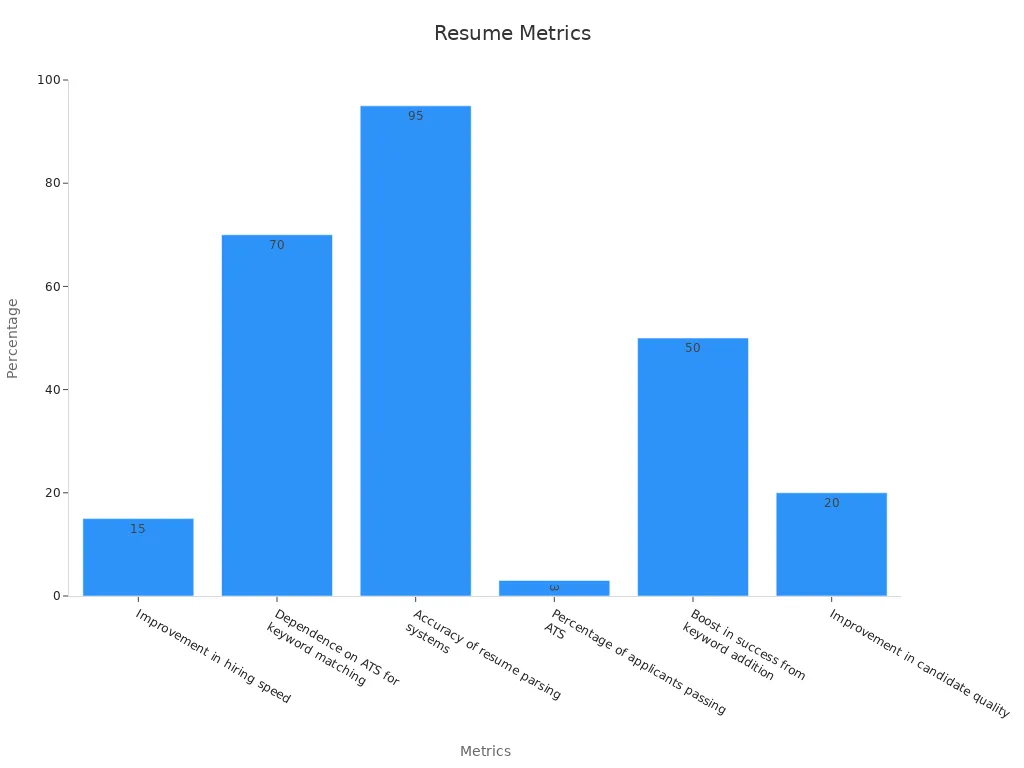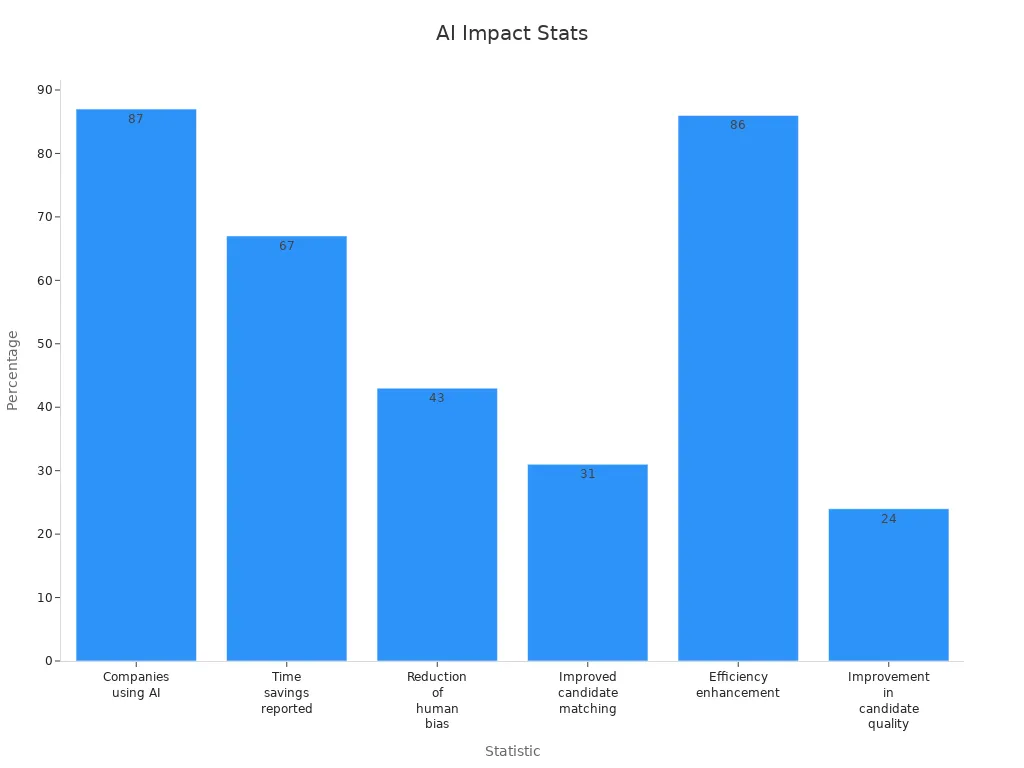What Are AI-Driven Tools for Candidate Shortlisting

AI-driven candidate shortlisting tools use artificial intelligence to simplify and enhance the hiring process. These tools analyze resumes, match candidates to job requirements, and rank applicants based on their qualifications. By automating repetitive tasks, they allow you to focus on strategic decisions.
Many companies have already embraced these tools. For example:
56% rely on it for screening.
67% report significant time savings.
AI-driven systems also reduce bias and improve fairness, helping you build a more diverse and talented workforce.
Key Takeaways
AI tools make hiring easier by sorting resumes automatically.
These tools help reduce bias, focusing on skills over personal details.
Companies save time with AI, letting HR talk to top candidates.
AI gives useful data, helping pick better hires and keep them longer.
Adding AI to tracking systems makes hiring faster and more accurate.
Why Is There a Need for AI in Candidate Screening?
Challenges in traditional candidate screening
Traditional candidate screening often involves manual processes that are time-consuming and prone to errors. Reviewing hundreds of resumes can overwhelm recruiters, leading to missed opportunities to identify top talent. Unstructured interviews and subjective evaluations further complicate the process, reducing the accuracy of hiring decisions. Studies show structured interviews predict job performance 60% more accurately than unstructured ones, highlighting the inefficiencies of traditional methods.
Additionally, unconscious biases can creep into manual screening, affecting fairness and diversity. Human evaluators may unintentionally favor certain candidates based on non-relevant factors, such as names or backgrounds. This lack of standardization can result in inconsistent hiring outcomes.
Increasing volume of applications and time constraints
The volume of job applications has surged in recent years. Between January 2021 and April 2023, application rates tripled weekly. During the first week of a job posting, applications are 2.5 to 3 times higher than in subsequent weeks. This influx creates significant time constraints for recruiters. In 2024, 60% of companies reported longer time-to-hire, which can frustrate candidates and lead to higher drop-off rates.
AI-driven candidate shortlisting addresses these challenges by automating resume screening and ranking candidates based on qualifications. For example, L'Oréal's AI chatbot reduced their time-to-hire by 33% while improving candidate satisfaction. By streamlining the process, you can focus on engaging with top candidates rather than sifting through irrelevant applications.
The need for unbiased and data-driven decision-making
Unconscious biases in hiring can hinder diversity and inclusion efforts. AI tools help mitigate this by standardizing evaluations based on skills and experience. Blind hiring techniques, powered by AI, ensure candidates are assessed fairly, fostering a more inclusive workplace. For instance, AI resume filtering eliminates subjective judgments, promoting equity in recruitment.
Data-driven insights also enhance decision-making. AI systems analyze vast amounts of data to identify patterns and predict candidate success. This approach not only improves the quality of hires but also supports long-term retention. By leveraging AI, you can make informed decisions that align with your organization's goals.
Benefits of Using AI-Driven Candidate Shortlisting

Improving the quality of hires
AI-driven candidate shortlisting enhances the quality of hires by focusing on skills and qualifications rather than subjective factors. These tools assess candidates objectively, ensuring that only the most suitable individuals are shortlisted. For example:
AI anonymizes candidate profiles, removing identifiers like names or photos.
It screens resumes for relevant skills and flags language that may indicate bias.
Structured interviews designed by AI improve the accuracy of candidate evaluations.
Research shows that AI assessments can reduce bias by up to 40% and increase the accuracy of matching candidates to roles by 50%. By relying on data-driven insights, you can minimize the risk of overlooking exceptional talent.
Reducing unconscious bias in recruitment
Unconscious bias often affects hiring decisions, even when recruiters aim to be fair. AI tools help reduce this bias by standardizing the evaluation process. They analyze resumes based on merit and eliminate subjective judgments. For instance:
AI HR software assesses candidates' skills meticulously.
It flags potential bias in assessments, ensuring fair treatment for all applicants.
These tools promote diversity and inclusion by focusing on qualifications rather than personal characteristics. As a result, your organization can build a more equitable and talented workforce.
Saving time and resources for HR teams
Manually reviewing resumes and conducting initial screenings can take hours. AI-driven candidate shortlisting automates these tasks, saving significant time and resources. According to industry data:
Metric Description | Improvement Percentage |
|---|---|
95% | |
Boost in employee satisfaction with career opportunities | 25% |
Reduction of bias in candidate selection | 25% |

By automating repetitive tasks, AI allows HR teams to focus on strategic activities like engaging with top candidates. This efficiency not only reduces costs but also improves the overall hiring experience.
Enhancing the candidate experience
AI-driven candidate shortlisting tools significantly improve the experience for job seekers. These tools streamline the application process, ensuring candidates receive timely updates and personalized interactions. For instance, L'Oréal's AI chatbot, Mya, reduced their time-to-hire by 33%. This efficiency led to higher candidate satisfaction scores and fewer drop-offs during the application process. When candidates feel valued and informed, they are more likely to view your organization positively.
You can also use AI to create a more engaging and user-friendly application process. Features like automated interview scheduling and instant feedback make the journey smoother for applicants. Recruiters benefit too, as they can focus on building meaningful connections with top talent. According to a survey, 42% of recruiters believe AI tools enhance their strategic capabilities, allowing them to prioritize candidate engagement over administrative tasks.
By leveraging AI, you can foster a positive impression of your company, which is crucial for attracting and retaining top talent. A seamless and transparent hiring process not only enhances the candidate experience but also strengthens your employer brand.
Providing data-driven insights for better decision-making
AI tools provide valuable data-driven insights that help you make informed hiring decisions. These insights analyze patterns in candidate behavior, qualifications, and performance, enabling you to predict success more accurately. For example, JetBlue Airways used data analytics to adjust its hiring criteria, prioritizing helpfulness based on customer preferences. This approach improved both retention and team performance.
Large organizations, such as those with over 10,000 employees, often rely on dedicated data analytics teams to support talent acquisition. AI-driven tools simplify this process by automating data collection and analysis. They also reduce recruitment costs by minimizing wasted resources. Unilever, for instance, shortened its recruitment cycle from four months to just four weeks while cutting costs by 50%.
AI-driven candidate shortlisting tools also promote diversity and inclusion. Objective algorithms mitigate unconscious bias, ensuring fair evaluations. By focusing on qualifications and cultural fit, these tools help you build a diverse and high-performing workforce. Additionally, automation decreases time-to-hire, allowing you to focus on building relationships with candidates rather than administrative tasks.
How AI-Driven Candidate Shortlisting Tools Work
Resume parsing and keyword matching
AI-driven candidate shortlisting tools begin by parsing resumes to extract key information such as skills, experience, and education. These tools use keyword matching to compare resumes against job descriptions, ensuring candidates meet the required qualifications. For example, AI parsers analyze resumes more accurately than human recruiters, achieving an impressive 95% accuracy rate. This precision helps recruiters identify top candidates quickly.
Many companies rely on applicant tracking systems (ATS) to streamline this process. In fact, 70% of large organizations use ATS for keyword matching. By automating resume screening, these tools reduce manual effort by up to 75%. This efficiency not only saves time but also improves the quality of hires by 20%.

AI-driven candidate scoring and ranking
Once resumes are parsed, AI tools assign scores to candidates based on their qualifications and relevance to the role. These scores help rank applicants, making it easier for you to focus on the most promising individuals. For instance, Helpware Tech developed a platform that ranks candidates using a similarity model. This model prioritizes candidates based on specific role criteria, allowing you to make informed decisions.
AI scoring systems also minimize subjective biases by relying on data-driven insights. Studies show that 86% of recruiters believe these tools enhance efficiency and reduce time-to-hire by up to 70%. Additionally, companies using AI-driven processes report a 24% improvement in candidate quality. By adopting these tools, you can manage larger talent pools while maintaining accuracy and fairness.
Predictive analytics for candidate success
AI tools go beyond scoring by using predictive analytics to forecast a candidate's potential success in a role. These systems analyze historical hiring data to identify patterns and predict outcomes. For example, forward-thinking organizations use advanced analytics to assess cultural fit and long-term performance. This approach improves the quality of hires and reduces turnover rates.
Unilever provides a great example of predictive analytics in action. By leveraging AI, the company reduced its hiring process by 15% while improving candidate quality. Such tools enable you to make strategic decisions based on reliable data, ensuring your hires align with organizational goals.
Integration with applicant tracking systems (ATS)
Integrating AI tools with applicant tracking systems (ATS) transforms how you manage recruitment. ATS platforms already streamline hiring by organizing resumes and tracking candidates. When combined with AI-driven candidate shortlisting, they become even more powerful. This integration enhances efficiency, accuracy, and the overall hiring experience.
AI tools work seamlessly with ATS through API integration. This connection allows data to flow between systems, enabling AI to analyze resumes, rank candidates, and predict success. For example, a case study revealed that integrating AI into ATS shifted recruitment strategies. It made the process faster and more human-centric by automating repetitive tasks and focusing on meaningful interactions.
To successfully integrate AI with ATS, you need to follow several steps:
Assess your current ATS and identify compatible AI tools.
Configure APIs to ensure smooth data exchange.
Map data fields to align AI outputs with ATS requirements.
Train your team to use the integrated system effectively.
Test the integration to ensure accuracy and reliability.
Monitor performance and optimize the system regularly.
This process ensures that your ATS and AI tools work together efficiently. It also improves privacy and security compliance, protecting sensitive candidate data. Continuous monitoring and feedback loops help refine the system, ensuring it meets your recruitment goals.
By integrating AI-driven candidate shortlisting with ATS, you can save time, reduce errors, and make data-driven hiring decisions. This combination allows you to focus on building relationships with top talent while the system handles administrative tasks.
Future Trends in AI Recruitment

Promoting diversity and inclusion through AI
AI is transforming recruitment by promoting diversity and inclusion. These tools analyze candidate profiles objectively, reducing unconscious bias and ensuring fair evaluations. For example, AI-powered systems anonymize resumes, removing identifiers like names and photos. This approach fosters equity in hiring and helps you build a diverse workforce.
Research supports this trend. Studies like Bridging the Gap highlight how AI enhances fairness and transparency when paired with diversity, equity, and inclusion (DEI) frameworks. Another study, Diversity and Inclusion in AI for Recruitment, emphasizes the importance of human oversight to avoid biases and legal risks. By combining AI with DEI strategies, you can create a recruitment process that values fairness and inclusivity.
Candidate-centric approaches and personalized experiences
AI-driven recruitment tools are shifting toward candidate-centric approaches. These tools personalize interactions, ensuring candidates feel valued throughout the hiring process. For instance, AI platforms send tailored email updates and use chatbots to provide instant feedback. Generative AI also conducts automated assessments to evaluate technical skills, cognitive abilities, and cultural fit, matching candidates to roles that align with their strengths.
Several companies have successfully implemented these strategies:
Vodafone: Achieved a 25% increase in internal mobility and reduced hiring costs by 30% using AI-powered video interviews.
PwC: Reduced initial screening time by 45% and increased representation from underrepresented groups by 15%.
Accenture: Used an AI platform to cut time-to-fill by 50% and improve candidate feedback by 40%.
These examples demonstrate how AI enhances the candidate experience while improving recruitment efficiency. By adopting these tools, you can create a hiring process that prioritizes candidate satisfaction and engagement.
Advancements in natural language processing (NLP) for better understanding of resumes
Natural language processing (NLP) is revolutionizing how AI tools analyze resumes. Modern AI-powered applicant tracking systems (ATS) use NLP to extract key information, such as skills and experience, with remarkable accuracy. These advancements reduce manual screening time by up to 75%, allowing you to focus on strategic tasks.
NLP also improves the quality of hires. AI-enhanced recruitment technologies increase hiring accuracy by 20%, ensuring candidates are matched to roles that suit their qualifications. Additionally, 84% of companies using recruitment automation report significant improvements in efficiency and scalability. By leveraging NLP, you can streamline resume screening and enhance the overall hiring process.
Ethical considerations and transparency in AI recruitment
AI-driven recruitment tools bring efficiency and fairness to hiring, but they also raise ethical concerns. You must consider how these tools handle sensitive data and ensure they operate transparently. Without proper oversight, AI systems can unintentionally reinforce biases, leading to unfair hiring practices.
One major challenge involves algorithmic discrimination. AI systems may develop biases based on gender, race, or other factors if trained on biased datasets. For example:
Algorithms might favor candidates from specific demographics due to historical hiring patterns.
Gendered language in job descriptions could influence AI's recommendations.
AI systems may unintentionally exclude qualified candidates by over-prioritizing certain keywords.
To address these issues, you should prioritize transparency and fairness in AI recruitment. Using unbiased datasets during training is essential. Regular audits of AI algorithms can help identify and correct discriminatory patterns. Additionally, you should ensure candidates understand how AI evaluates their applications. Providing clear explanations builds trust and promotes fairness.
Transparency reports also play a critical role. These reports highlight how AI systems make decisions and what data they analyze. For instance, studies recommend enhancing algorithmic transparency to mitigate biases. By sharing this information, you can demonstrate your commitment to ethical hiring practices.
Ethical AI recruitment requires a balance between innovation and responsibility. When you adopt AI tools, focus on fairness, transparency, and inclusivity. This approach not only improves hiring outcomes but also strengthens your organization's reputation as an equitable employer.
Top AI Tools for Candidate Shortlisting
Ideal: Automates screening and shortlisting with AI-driven best-fit candidate recommendations.
Ideal is a powerful tool designed to simplify your recruitment process. It uses AI to screen resumes and recommend candidates who best match your job requirements. By analyzing skills, experience, and qualifications, Ideal ensures you focus on the most suitable applicants. This tool also integrates seamlessly with applicant tracking systems (ATS), making it a valuable addition to your hiring strategy.
Ideal’s AI-driven approach improves efficiency and accuracy. It eliminates manual errors and reduces the time spent on initial screenings. Recruiters have reported higher-quality hires and better retention rates after implementing Ideal. If you’re looking for a tool that combines automation with precision, Ideal is an excellent choice.
hireEZ: Combines AI sourcing, recruitment CRM, and automated resume screening.
hireEZ stands out for its comprehensive features, including AI sourcing, recruitment CRM, and resume screening. It simplifies the hiring process by finding candidates who might not appear in traditional searches. Users praise its Boolean search capabilities, which are as intuitive as LinkedIn but provide more detailed candidate profiles.
Key benefits of hireEZ include:
Sourcing Capabilities: Recruiters find unique candidates, leading to successful hires.
Ease of Use: The platform’s user-friendly interface enhances productivity.
Integration: hireEZ works well with ATS systems, streamlining your recruitment workflow.
According to G2, hireEZ has a 4.6/5 rating, while Capterra users rate it 4.5/5. Jessica Hajsan, CEO of Hire Mint Recruitment, says, “I would use hireEZ every single day in my role as an executive recruiter.” These endorsements highlight its effectiveness in AI-driven candidate shortlisting.
SeekOut: Offers an AI-powered talent search engine for finding passive candidates.
SeekOut specializes in sourcing passive candidates, making it ideal for industries like tech and healthcare. Its AI-powered talent search engine pulls data from diverse sources, including LinkedIn, GitHub, and Stack Overflow. This broad reach helps you find niche talent that other tools might miss.
Organizations like Unilever have seen remarkable results with AI-driven sourcing strategies. They reduced recruitment cycles from four months to four weeks and cut costs by 50%. SeekOut’s ability to automate repetitive tasks and match candidates by qualifications enhances diversity and retention. For medium and large organizations, SeekOut provides a competitive edge in finding top-tier talent.
AmazingHiring: Specializes in sourcing tech candidates with AI-driven attribute searches.
AmazingHiring is a powerful tool designed to help you find top technical talent. It specializes in sourcing candidates with AI-driven attribute searches, making it a favorite for large staffing agencies and enterprises. This tool connects various online profiles, such as LinkedIn and GitHub, to give you a complete view of a candidate’s skills and experience. By using advanced search filters, you can quickly narrow down your options and focus on the most qualified individuals.
One of AmazingHiring’s standout features is its ability to discover email addresses for candidates who may not respond on LinkedIn. This increases your chances of reaching out to passive candidates. The tool also uses AI to suggest the best profiles for your job openings. It updates these suggestions regularly, ensuring you always have access to the most relevant candidates. These features make AmazingHiring an excellent choice for sourcing tech professionals efficiently.
Findem: Uses AI to conduct attribute-based searches for enhanced recruitment.
Findem takes recruitment to the next level with its attribute-based search capabilities. Unlike traditional tools that rely on keyword matching, Findem allows you to search for candidates based on both technical and intangible attributes. This approach gives you deeper insights into a candidate’s qualifications and potential fit for your organization.
As an AI-driven talent data platform, Findem streamlines the early stages of recruitment by leveraging a vast network of connected data points. It transforms how you identify and evaluate candidates, offering a more comprehensive view of their skills and experiences. For example, Findem’s innovative search methodology helps you uncover candidates who might otherwise be overlooked, ensuring you don’t miss out on top talent.
By using Findem, you can enhance your recruitment process and make more informed hiring decisions. Its focus on attributes rather than just keywords aligns perfectly with the goals of AI-driven candidate shortlisting, helping you build a stronger and more diverse workforce.
AI-driven candidate shortlisting tools revolutionize recruitment by offering unmatched efficiency, fairness, and precision. These tools save time, reduce bias, and improve the quality of hires. For example, 67% of companies report significant time savings, while 43% highlight reduced human bias. The widespread adoption of AI, with 87% of companies using it, underscores its transformative impact.
Statistic | Percentage | Description |
|---|---|---|
Companies using AI | 87% | Indicates widespread adoption of AI in recruitment. |
Time savings reported | 67% | Companies cite time savings as a key advantage of AI. |
Reduction of human bias | 43% | AI reduces bias, fostering fairer hiring practices. |
Improved candidate matching | 31% | AI ensures better alignment between candidates and roles. |
Efficiency enhancement | 86% | Recruiters report enhanced efficiency and faster hiring. |
Improvement in candidate quality | 24% | AI-driven processes lead to better quality hires. |

Adopting AI in recruitment ensures you stay competitive in a fast-evolving job market. These tools not only streamline hiring but also enhance the candidate experience, making your organization more attractive to top talent. Explore AI-driven solutions today to transform your hiring process and build a stronger workforce.
FAQ
What are AI-driven tools for candidate shortlisting?
AI-driven tools use artificial intelligence to analyze resumes, rank candidates, and predict their suitability for a role. These tools automate repetitive tasks, helping you save time and make data-driven hiring decisions. They also reduce bias, ensuring fairer recruitment processes.
Are AI tools for recruitment expensive?
Many AI tools offer scalable pricing models. You can choose plans based on your hiring needs. Some tools even provide free trials or basic versions. This flexibility ensures you can find a solution that fits your budget while improving your recruitment process.
How do AI tools reduce unconscious bias?
AI tools evaluate candidates based on skills and qualifications rather than personal identifiers like names or photos. This standardization minimizes subjective judgments. For example, blind resume screening ensures fair assessments, promoting diversity and inclusion in your hiring process.
Can AI tools integrate with existing recruitment systems?
Yes, most AI tools integrate seamlessly with applicant tracking systems (ATS). This integration allows you to streamline workflows, automate resume parsing, and access data-driven insights. It also ensures a smoother hiring process without disrupting your current systems.
Are AI-driven tools suitable for small businesses?
Absolutely! AI tools cater to businesses of all sizes. Many platforms offer affordable options tailored to small businesses. These tools help you save time, improve candidate quality, and compete with larger organizations in attracting top talent.
See Also
Enhancing Candidate Experience With AI Recruitment Tools
Using AI Recruitment Software To Forecast Candidate Success
AI Hiring Software Offering Smart Interview Solutions
From recruiting candidates to onboarding new team members, MokaHR gives your company everything you need to be great at hiring.
Subscribe for more information

